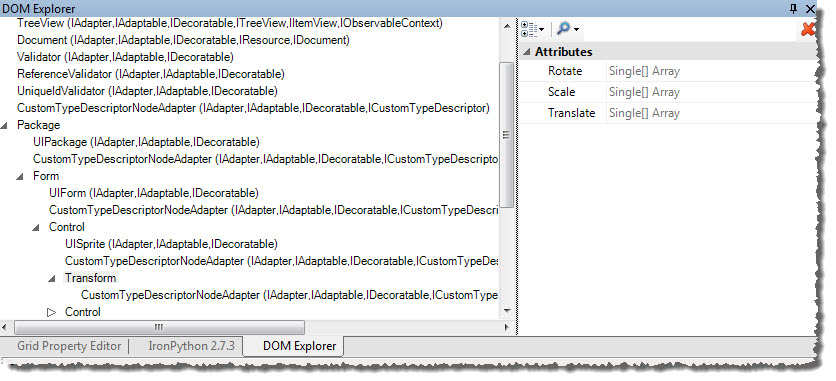-
Notifications
You must be signed in to change notification settings - Fork 263
Using DomExplorer
DomExplorer, in the Sce.Atf.Dom namespace, is a MEF component you can use to visualize the contents of a DomNode tree in a tree view. The ATF DOM Tree Editor Sample imports DomExplorer, whose window is shown in this figure:

The left pane of DOM explorer shows a tree view of all the nodes in the application data's DomNode tree. DomNodes are listed by name, taken from the DomNodeType.Name property. All the node's DOM adapters are listed as its children, along with all the interfaces that node implements, in parentheses after the adapter name. For example, the "Package" node has two adapters:
-
UIPackage, the primary DOM adapter for this node. -
CustomTypeDescriptorNodeAdapter, a DOM adapter added to all nodes to manage property descriptors.
UIForm and CustomTypeDescriptorNodeAdapter adapters), which in turn contains a "Control" node (with UISprite and CustomTypeDescriptorNodeAdapter adapters).
The right pane of DOM explorer contains a property editor that enables you to view the DomNode type's attributes and their types, if any. The property grid is for information only; you cannot edit attribute values. In the figure, the selected "Transform" node has three attributes: "Rotate", "Scale", and "Translate", all arrays of type Single.
To learn more about the DOMTreeEditor sample and its DOM adapters, see DOM Tree Editor Programming Discussion.
You can add DOM Explorer to an application by adding the DomExplorer component to the TypeCatalog of the application, as you would any other MEF component.
Development, Debugging, and Testing
-
Debugging the DOM with Visual Studio: Shows how to get
DomNodeinformation to help you debugging a DOM. - Visual Studio Debugger Display Attributes and Other Features: Learn about enhancing debugging in Visual Studio by using debugger display attributes and other facilities in C#.
- Using DomExplorer: Tells about a component you can use to visualize the contents of a DOM node tree.
-
Using the DomRecorder Component: Discusses the
DomRecorderand the DOM events it records and shows an example. - General ATF Scripting Support: Explains ATF's facilities to script applications, accessing C# objects in application classes.
-
Scripting Applications with Python: Shows how to use the
BasicPythonServiceandPythonServicecomponents to script an ATF application. - ATF Test Code: Discusses the classes to facilitate writing tests for ATF-based applications as well as ATF test code.
- Writing Python Scripts for ATF Applications: Shows how to write Python scripts for ATF applications, using existing examples.
![]()
- Home
- Getting Started
- Features & Benefits
- Requirements & Dependencies
- Gallery
- Technology & Samples
- Adoption
- News
- Release Notes
- ATF Community
- Searching Documentation
- Using Documentation
- Videos
- Tutorials
- How To
- Programmer's Guide
- Reference
- Code Samples
- Documentation Files
© 2014-2015, Sony Computer Entertainment America LLC